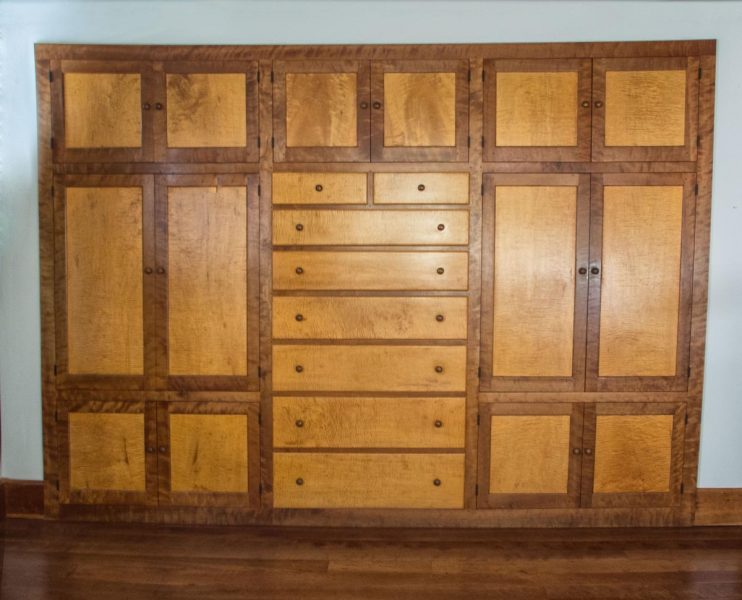There are many things that I have learned as a woodworker over the years, but two of the most important are the myth that only narrow glued up boards are stable, and, the importance of matching wood. Since my high school shop days I have been told that the only way to insure stability in wood is to rip the boards up into smaller pieces and glue them back together, alternating the growth rings if possible. I still hear this today, delivered as if it is the gospel, an unassailable truth. I learned woodworking from many sources including my father and at school, also reading books on the subject and going to museums and exhibits, but one of my greatest teachers was the antique furniture that we had the opportunity to explore and restore in our furniture business. We would work on pieces that were hundreds of years old and still had their beauty and structural integrity, due mainly to the quality of the materials, the craftsmanship, and the appreciation of generations of owners. One thing that really stood out is how many of the pieces had single board sides and tops, particularly the walnut and mahogany pieces, and that they were still intact and functional, even most of the drop leaf tables that hung to the floor. It was readily apparent from this furniture that wood did not have to be glued up for stability and structural reasons. Furthermore, we saw more trouble with the pieces with glued up lumber, probably because the original hide type glues are not as powerful as modern adhesives, but a point was made. It is obvious that man-made adhesives cannot outperform the pure strength of wood, that in the absence of destructive insects and placed in a good environment, its longevity is assured. It is also hard to deny the inherent beauty of the wide boards, especially the ones that had interesting grain characteristics that move across the whole surface, and from a mature tree that had lived a good, full life.
When we started building furniture our goal was to make it to the standard of the originals, which led us to producing our own lumber to get wide and interesting material. We built hundreds of case pieces over the years and the majority of the walnut, mahogany, and cherry ones were built with single boards. I do not recall having any problems, certainly not to the extent that we ever had to replace a side. We also constructed a lot of tables using wide matched boards, and while they were a little more problematic, the end result was worth the effort. We definitely learned wood couldn't just be taken off the pack, run through the planer and be expected to remain flat, which may be why manufacturers glue up small pieces, it is expedient and minimizes those potential problems. Working with wider boards takes a little more time and care, and it took us awhile to learn how to minimize the problems. Lumber spends a good part of its life weighed down, whether on stickers while drying or in a pack, so the wood needs a little time to assume its natural position. Likewise, rails and stiles, drawer fronts and panels cut from boards have to be able to adjust to a new environment, no longer bound by the wood beside them or pressing on them. We learned to set the boards out to acclimate, usually leaning almost vertically against a wall with the air free to circulate around each board while we started other phases of the project. Case sides were simpler as the construction design helped hold them in position, and tops were usually fastened to a framework, but table tops, bed posts and rails and stiles needed more care. As far as the rails and stiles were concerned, we would rough rip them extra wide while working on the case, then mill them flat after they had adjusted to their new circumstances. They didn't need to set long, as most of the movement happened quickly, but there was nothing more aggravating and costly than going back and replacing a recalcitrant rail after the piece was finished, trying to match a new one to the existing piece. Luckily, wide live edge lumber is in vogue now, and those makers have figured out how to work with the wood, so hopefully that misconception can be put to bed.

The concept of matching lumber was more a sort of slow revelation, one that only in retrospect was in plain sight. I don't remember in my formative woodworking years that there was a lot of emphasis on the lumber itself, it was more about design, construction and finish. Even my father, who was a good and a particular craftsman, would try to find the nicest wood in his inventory for the focal points of the piece, but generally made do with what he had on hand. Again, from the old pieces, we learned about the inherent beauty of matching wood. When you think of the dynamics of the day and look at antique furniture, its obvious that many of the pieces were built from the wood of a single tree, from a supplier that might be lucky to saw a few logs a day. In contrast, modern mills can cut 100,000'+ board feet of of lumber per day from 100's of logs. There can be a great deal of variation within a species, and when the wood is jumbled together, it often requires a homogenizing finish to give the piece a false harmony, at the expense of the inherent beauty of the wood. When you can work with the natural beauty of the wood, and use that beauty as a focal point of your piece, that is the ultimate. It was pioneers like Wharton Esherick and George Nakashima that exposed many aspiring woodworkers to the idea that the wood itself should play a prominent role in the process. It should, in fact, be the distinguishing feature, everything should be done to enhance rather diminish its appeal, and in their case, the wood helps dictate the design. I also learned from reading James Krenov of the beauty of book matching wood, in his case mostly for matching panels in his cupboards, but it became quickly apparent that his ideas and attention to detail could be applied to many areas of woodworking, that paying greater attention to the lumber could elevate a project. In our furniture business we tried to showcase the lumber as the focal point, especially since we were all pretty much using similar designs, finish and joinery. It invariably gave us a leg up on our competition, who rarely shared our wood obsession to the same degree or had access to the types of lumber we were producing ourselves.

Once a customer is aware of the deliberate wood matching and use of wide boards, especially for table tops, they will never look at a piece of furniture the same way again. The irony was that we were not smart enough to pursue this as a business strategy, it was just how we wanted to make our furniture, but it ultimately worked in our favor. It did really seem to matter to our customers, who embraced the idea, and it created a lot of interest on their part. More than one customer teasingly chided me for ruining her appreciation for the rest of the furniture in her house, but I took it as a backhanded compliment. Custom furniture and mill work require quite an investment on the part of the customer, and when they feel that they are getting something very special, with great attention to detail, it generates enthusiasm, appreciation and loyalty. Customers want to feel that they are getting good value for their investment, and a job well crafted with beautiful and carefully matched lumber will give them the return that they are hoping for.
It has been rewarding to take this approach with our furniture, and now be able to source these types of material for other woodworkers. After years of making custom furniture to order and trying to figure out and meet each customers expectations, woodworkers are a relative joy to deal with and we are further from the epicenter. I have often said it felt like we moved from the cab to the caboose when we sold our shop and started doing just the lumber, still on the train but no longer at the point. I have the ultimate respect for anyone trying to do this for a living, and I hope we can make the job a little easier.


Very interesting blog. I work with large material mostly and do not arbitrarily join wood if I can keep from it. A good book matched panel oozes symmetry and beauty not found in two random boards for sure. Of course the wood should be dryed and allowed to acclimate to its environment. My shop is heated and cooled as I live in texas where the big swings in temperature and humidity can adversely affect the stability of the project. Enough said, thanks for the info.
Hi, Bert/Lou!!!!
I have really enjoyed reading your website! So glad to see that you and Wanda, and now Aubrey — and company are happy doing what you love and that you are doing so well. Loved all the photos! Reading about the Berwyn Furniture Shop and your earlier business brought back many memories. Dan and I love the beautiful wood in the bed that your folks made for us many years ago.
Sending all of you love,
Robin 🙂